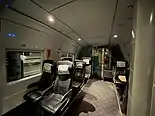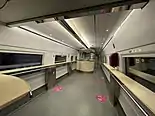Renfe Class 103
The Renfe Class 103 is a high-speed train used for the AVE service and operated in Spain by the state-run railway company RENFE. The trainset is also known as S103 or S/103.
| Renfe Class 103 | |
|---|---|
 Series 103 train, Velaro E | |
 The interior of a S103 train. | |
| In service | 2007 - present |
| Manufacturer | Siemens |
| Family name | Velaro |
| Number built | 26 trainsets |
| Formation | 8 cars (driver and passenger integrated cars at either end) |
| Capacity | 404 |
| Operator(s) | Renfe |
| Line(s) served | Madrid - Barcelona Madrid - Figueres |
| Specifications | |
| Car body construction | Aluminium |
| Car length | 25.7 m (84 ft 3+3⁄4 in) (Cab car) 24.2 m (79 ft 4+3⁄4 in) (Intermediate car) |
| Width | 2.95 m (9 ft 8+1⁄8 in) |
| Maximum speed | 310 km/h (193 mph) (service) 350 km/h (217 mph) (certified) 403.7 km/h (250.8 mph) (test) |
| Weight | 425 t (418 long tons; 468 short tons) |
| Power output | 8,800 kW (11,800 hp) |
| Tractive effort | 283 kN (64,000 lbf) Starting 250 kN (56,000 lbf) Cont. @125 km/h (78 mph) |
| Electric system(s) | 25 kV 50 Hz AC Overhead catenary |
| Current collector(s) | Pantograph |
| UIC classification | Bo′Bo′+2′2′+Bo′Bo′+2′2′ +2′2′+Bo′Bo′+2′2′+Bo′Bo′ (8 car set) |
| Safety system(s) | LZB, ASFA 200, ERTMS |
| Track gauge | 1,435 mm (4 ft 8+1⁄2 in) standard gauge |
The trains were constructed by Siemens, as the second member of the company's Velaro family.
History
On 24 March 2001, Siemens won one half of RENFE's tender to supply 32 high-speed trains for the Madrid-Barcelona high-speed rail line, offering a modified version of the ICE 3 high-speed train used by German Railways (Deutsche Bahn) for its InterCityExpress service. Changes involved an up-rate to higher power (8,800 kW or 11,800 hp) for higher acceleration and top speed to cover the 651 km (405 mi) between Barcelona and Madrid in 2h30m, the ability to operate in a high range of temperatures, and a different interior.
The ICE 3 trains were a joint production with other Germany-based train manufacturers, who refused to supply parts or sell licenses to Siemens for the AVE Class 103. This caused a delay (for which Siemens eventually paid €21 million), during which Siemens had to re-develop the missing components. However, at the end of this development, Siemens had a complete high-speed train platform, which it named Velaro. The AVE Class 103 was intended as only the second member of a whole family after ICE 3, therefore, it was named by Siemens as the Velaro E.
The AVE Class 103 has been certified to run at 350 km/h (217 mph). During testing between Madrid and Zaragoza, on 16 July 2006, train 005 reached 403.7 km/h (250.8 mph).[1] This is both the current national rail speed record for Spain, and also the current speed record for a normal series train in standard configuration.
On 23 December 2005, RENFE ordered a further 10 identical trains (Siemens designation Velaro E2). Currently, all 26 trains from both orders have been delivered and are in service.
Specifications
The certified top speed of the AVE Class 103 is 350 km/h (217 mph), currently the highest for any train in the world, although the Alstom AGV, currently conducting extensive tests, aims for certification at 360 km/h (224 mph).
The class has distributed traction, traction equipment was moved underfloor, with powered bogies distributed in alternate carriages along the length of the train. This removes the need for driving units at either end, which AVE Class 100 and 102 have, allowing a better use of space, better energy efficiency, better acceleration at lower speeds, and better ability to climb grades. For the AVE Class 103, four of the eight cars were fitted with two powered bogies each.
Electronically, the train is actually two identical half-trains of four coaches each, each with an independent power system, apart from the active pantograph (only a single pantograph is raised on AC-fed rail lines) and a high voltage line along the entire length of the 8-car train.
The train's capacity of 404 passengers is split between three classes; with two coupled 8-car trains total capacity is therefore 808 passengers. In the end coaches (driving trailers), glass screens separate the driver and passengers, and allow passengers the same views as the driver, just as in the ICE 3 and other Velaros. The driver can turn these opaque if necessary or preferred.
 Preferente Class
Preferente Class Turista Class train interior
Turista Class train interior Interior of the Cafeteria Car
Interior of the Cafeteria Car Area next to the train door and restroom
Area next to the train door and restroom
In service
The AVE Class 103 entered commercial service on 22 June 2007,[2] between Madrid and the temporary end of the line to Barcelona near Tarragona.
While the trains and the tracks were commissioned for a regular top speed of 350 km/h (217 mph), the train control and signalling system necessary for such operation, ETCS Level 2, was not ready for service. Thus commercial top speed is limited to the maximum Spanish authorities approve for the line with ETCS Level 1 since 2011, 310 km/h (193 mph).[3]
ERTMS is technically capable of supporting speeds of up to 500 km/h (311 mph), but the signal spacing on the Madrid-Barcelona line was initially, from 7 May 2007, only sufficient to support speeds of 300 km/h (186 mph). In October 2011 the speed was raised to 310 km/h (193 mph) on parts of the railway.[4]
From the opening of the Córdoba–Málaga high-speed rail line on 24 December 2007, the AVE Class 103 were also used from Madrid to Málaga.
On 20 February 2008, the final section of the Madrid–Barcelona high-speed rail line into Barcelona was opened. From that day, the AVE Class 103 were used for the faster services between Madrid and Barcelona, achieving the shortest travel time of 2h30m on the non-stop runs.[5]
References
- "Ficha de 9-103-005-5" (in Spanish). Listado del Material Ferroviario Español. Retrieved January 16, 2009.
- "First passengers travel on world record train Velaro" (PDF). Siemens. June 22, 2007. Retrieved January 16, 2009.
- "15 años de Ave: de ilusión por el progreso a símbolo del desarrollo presente y futuro de España" (PDF) (in Spanish). Ministry of Public Works and Transport (Spain). April 21, 2008. Retrieved January 16, 2009.
- Madrid - Barcelona at 310 km/h with ETCS Level 2
- "Barcelona, nuevo destino AVE" (PDF). Revista del Ministerio de Fomento. Nº 571 (in Spanish). Ministry of Public Works and Transport of Spain. March 2008. Retrieved January 16, 2009.
